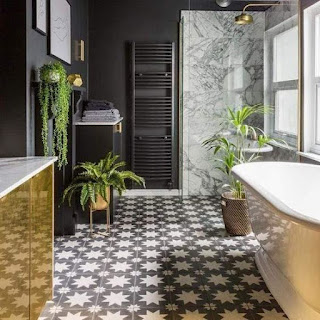When you're considering how to design a Victorian bathroom, there's no need to be restricted to old-fashioned styles. In fact, one of the biggest influences on how your bathroom looks today, may well be the Victorian style. That's because this style - originally designed for the industrial working class - bore such strong aesthetic similarities to Victorian times that many people started thinking about "lifestyles" associated with this time in history. This has made the Victorian bathroom one of the most popular designs today, for good reason: it's warm, elegant style makes for a perfect, welcoming bathroom.
Tricks for Combining Victorian Bathroom Elements
If you'd like to incorporate some elements from the Victorian style bathroom, you'll want to pay close attention to two particular components: plumbing and tiles. These will provide the basis for your whole room's look - remember, this was designed around the standard tub/shower combination. Although modern plumbing isn't usually included in a vintage setup, remember that the original toilets (often provided by the builder) were often dug straight into the ground, requiring a certain amount of upkeep. Just like modern plumbing, this also requires regular maintenance and care to keep your drains clean and free of debris.
Let's start with indoor plumbing. Your Victorian bathroom may well boast an upstairs window that overlooks the room, which gives you the opportunity to take advantage of what was often a Victorian era luxury. In these days, however, indoor plumbing rarely consists of exposed pipes. Instead, most systems will be installed inside the wall, with pipes either running to the floor or placed through small openings in the walls. Remember that you don't have to stick to the standard tub/shower combination; many times the Victorian era provided innovations such as hand-held showers and tissue dispensers.
Important Components of a Victorian Bathroom
Fixtures are also an important component of your Victorian bathroom, especially with regards to sinks and bathroom countertops. Sinks used in these bathrooms were quite rudimentary in comparison to today's designs. Common materials used included porcelain, copper, and even stone. Copper was a popular material as it was strong and durable, but unfortunately was prone to chipping and fading. Porcelain was usually more expensive, though still relatively cheap when compared to other materials at the time. Finally, limestone was often used for countertops due to its anti-slip qualities.
As for bathroom countertops, the options available to you in the Victorian era are nearly endless. Sinks came in all shapes and sizes and could be made of porcelain, copper, limestone, slate, or even glass. Overhead fixtures such as shelves and overhangs were commonly used. As you can see, the possibilities with sinks and countertops are almost limitless, making them the center point of any bathroom's design.
Best Victorian Bathroom Floor Designs
Flooring for Victorian bathroom floors was fairly standard and was often made of natural stones. Hardwood floors were quite popular due to its appeal and durability. Linoleum was most common, but could be found in darker shades as well. Porcelain tile was quite common and could be found in a variety of colors including light green, cream, dark blue, ivory, and gold. Bathtubs, too, came in a wide variety, with the most common types being pedestal, claw-foot, double boiler, tub over the full size, and freestanding.
Lighting in the Victorian bathroom can be subdued or quite elaborate. For instance, many bathrooms had a large chandelier above the mirror and several smaller chandeliers throughout the rest of the bathroom. There would also be numerous pendants lights tied into the ceiling, allowing for soft, beautiful lighting to filter into the room. To add a sense of depth, many bathrooms had three candle holders decorating each floor in the Victorian era bathroom.
Another feature that was quite common in Victorian bathrooms was that of the brass and gold trims on the faucets. The brass was usually scrolled, while the gold was usually hammered into designs such as hearts, roses, and angels. The fixtures themselves were very ornate, in both design and size. Many were intricately engraved, while others were hand-painted in beautiful patterns. Many of these ornate pieces still exist today, as well as reproductions. They can be purchased online or at antique stores.












0 comments:
Post a Comment